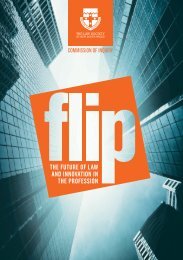Legal Mosaic Essays on Legal Delivery
1Tx15vb
1Tx15vb
You also want an ePaper? Increase the reach of your titles
YUMPU automatically turns print PDFs into web optimized ePapers that Google loves.
<str<strong>on</strong>g>Legal</str<strong>on</strong>g> <str<strong>on</strong>g>Mosaic</str<strong>on</strong>g>: <str<strong>on</strong>g>Essays</str<strong>on</strong>g> <strong>on</strong> <str<strong>on</strong>g>Legal</str<strong>on</strong>g> <strong>Delivery</strong><br />
ple of Picasso’s late Cubist style. In Cubism, the subject of the artwork<br />
is transformed into a sequence of planes, lines, and arcs. Cubism has<br />
been described as an intellectual style because the artists analyzed the<br />
shapes of their subjects and reinvented them <strong>on</strong> the canvas. The viewer<br />
is left to rec<strong>on</strong>struct the subject and space of the work by comparing<br />
the different shapes and forms to determine what each <strong>on</strong>e represents.<br />
Through this process, the viewer participates with the artist in making<br />
the artwork make sense .It is for the audience to cobble together<br />
the multitude of seemingly disparate images and elements to represent<br />
the subject in a greater c<strong>on</strong>text. This appears to be the approach that<br />
many legal pundits are taking to the way they paint the current legal<br />
landscape; they translate the <strong>on</strong>ce m<strong>on</strong>olithic legal topography—<strong>on</strong>e<br />
where a law firm “handles the case” start to finish (including back office<br />
functi<strong>on</strong>s)—into a cubist rendering that identifies and isolates different<br />
parts of the process that now include additi<strong>on</strong>al providers outside<br />
the firm. Each provider in the supply chain is analyzed exhaustively,<br />
but the viewer—as with the cubist painters-- is left to make sense of<br />
these seemingly disparate actors in the supply chain and, more particularly,<br />
how they mesh.<br />
Let’s start with a term that has come to frame the discussi<strong>on</strong> of the legal<br />
industry:<br />
Unbundling<br />
Unbundling is a neologism initially used to describe how the ubiquity<br />
of mobile devices, Internet c<strong>on</strong>nectivity, c<strong>on</strong>sumer web technologies,<br />
social media and informati<strong>on</strong> access in the 21st century are affecting<br />
older instituti<strong>on</strong>s such as educati<strong>on</strong>, broadcasting, newspapers, games,<br />
shopping, etc. These new devices break up the packages (think: law<br />
firm “handles the case”), replacing them with particular parts at a scale<br />
and cost unmatchable by the old order. Unbundling has been called<br />
“the great disruptor”.<br />
8



